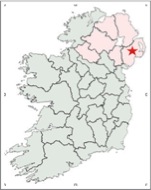
This paper discusses the High Crosses of County Down. There is a heavy concentration of ancient high crosses in County Down, 12 in total. They are: Bangor; Clonlea, North Cross; Clonlea, South Cross; Donaghmore; Downpatrick Cathedral Cross; Downpatrick North Cross; Downpatrick South Cross; Downpatrick two Fragments of one cross; Downpatrick Fragment of another cross; Dromore; Drumgooland; and Kilbroney. Where information is available there is a section on the history of the site, brief information about the primary saint related to the site and a description of the cross or crosses at the site. Except where noted, the photographs were taken by the author. Directions to the sites reference The Official Road Atlas Ireland. Maps related to the sites are cropped from Google Maps.
The history of County Down revolves around the town of Down, more commonly Downpatrick. A hill fort was erected there long before the Christian era. Early on it was named “Rath Cealtair, or Dun Cealtair, the fort of Celtchar. Celtchar, or Celtchar-of-the-Battles, as he was called, was one of the heroes of the Craoibh Ruadh, or Red Branch of Ulster and a companion of the famous Connor MacNessa, King of Ulster.” Connor MacNessa was a figure in the Ulster Cycle, a king in the pre-history of Ireland. Another pre-Christian name applied to Downpatrick was Dun-da-leth-glas. This name appears in some early ecclesiastical documents. This was shortened to “Dun”, the hill fort, hence the name Down. Some time after the beginning of the Christian era, the name of the patron saint, Patrick, was added to the name of the place and it became Downpatrick. (Official Tourist Guide to County Down . . , p. 123)
There are numerous other early Christian sites. The earliest Christian site in County Down is at Saul, just northeast from Downpatrick. Tradition states that this was the site of St. Patrick’s first church. He landed near here and a local chieftain, Dichu gave him a barn for his first church. Kilbroney was another of the early foundations, established in this case by the Virgin Bronach. The Nendrum monastic site on Mahee island was established in the 5th century by St. Machaoi. (Meehan, pp. 206, 212, & 223)
In the 10 and 12th centuries the area was plundered by the Norsemen.
In the 12th century, John de Courcy, an Anglo-Norman took the fortress at Downpatrick, defeating Rury MacDonlevy, the King of Ulster. (Official Tourist Guide to County Down . . , p. 124) In 1183, De Courcy founded a Benedictine Abbey at Downpatrick.
Bangor Abbey and Cross
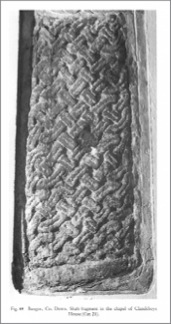
The foundation of the Bangor Abbey is credited to Saint Comgall. He was born in 517 and founded the Abbey in about 555. The early name of the place was Inver-Beg, meaning “the river mouth.” The name later became Bean-Choir, meaning “white Church.”
The photo to the left is from Harbison, 1992, Vol. 2, Fig. 69.
The Danes and Norsemen attacked, plundered and destroyed the Abbey in the period of 810-822. It is recorded that the Abbot and 900 of the monks were killed.
In the year 1120, the great saint and Irishman, Saint Malachv, became Abbot of Bangor. St. Malachy rebuilt the church, which flourished for the next 300 years. He resided there until called to the See of Down and Connor, and later to the Primacy of Armagh.
In the year 1469 the Abbey passed from the possession of the Regular Canons and was transferred by Pope Paul II. to the Franciscans, and from them, at a later period, to the Augustinians. It remained with them until the dissolution of the monasteries under Henry VIII. (Brennan, 509-512)
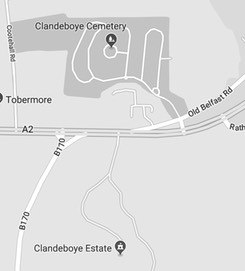
The remaining fragment of what was likely a high cross is a section of a shaft that may have come from the Abbey at Bangor. The only carving visible consists of two strand interlace. It is built into the wall of the private chapel of Clandeboye House, Bangor. (Harbison, 1992, p. 26)
Getting There: See the Road Atlas page 12, F 4. Clandeboye is named on the map. Located on the northeast edge of Bangor, just off the A2, on the grounds of the Clandeboye Estate. Access by permission only. I have been unable to gain access. The map above is cropped from Google maps.
Clonlea Crosses:
The Clonlea Crosses General
In the Clonlea graveyard there are three crosses. The North cross is ancient, the middle cross is modern and the South cross seems to be a post 1200 cross in an ancient base. Dorothy Kelly pointed out to locals that where such an ancient cross and cross base are found, there was probably a monastic settlement with a church. Kelly suggested a date between 800 and 900 for the cross. (E Hughes, 2015)
Clonlea, North
The North cross stands about seven feet high. In the center of the east face (pictured left) there appears to be a ringed cross or an image of Christ on the cross. The shaft seems to be divided into panels which contain figural sculpture too worn to clearly identify. Harbison suggests the second panel up may represent Noah’s Ark. (Harbison, 1992, p. 48)
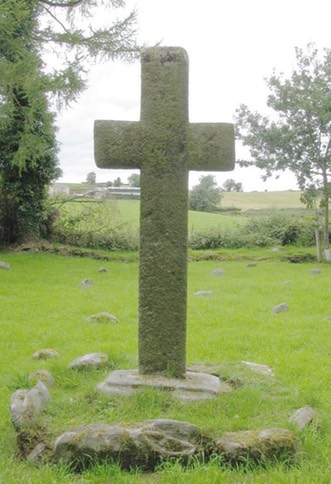
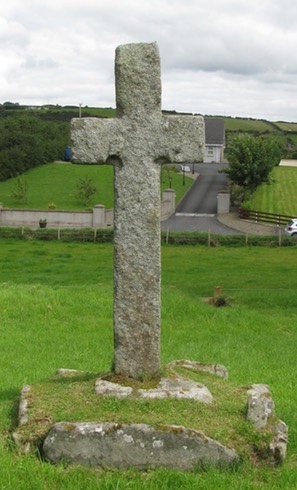
The west face is pictured above right. It also seems to have panels too worn to identify.
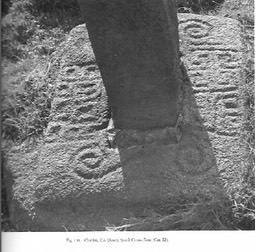
The South Cross
This cross may or may not be ancient. It bears an inscription “P Mc M 1842” suggesting it was either erected that year, or reworked then from an older cross. The initials refer to a Patrick McMullan. (E Hughes, 2015)
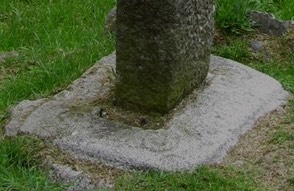
The Base is ancient. The carving is described by Harbison. “It bears spiral decoration on the north and south ends of the top. On the west there are C-shaped spirals and, on the east, what seem like two sets of interlace forming four squares.” (Harbison, 1992, pp. 47-48, photo above right Vol. 2, Fig. 131)
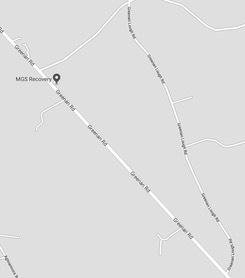
Getting There: See the Road Atlas page 19, C 4. Located to the northeast of the A2 between Newry and Warrenpoint. At the south end of the village of Burren, take the Greenan Road, going northwest for about 1 mile. A road signposted as Greenan Lough Road will take off to the right. Take this right for about .5 miles. A small field and then a graveyard will be on your left.
The map is cropped from Google Maps.
Donaghmore Cross:
This is a composite cross south of the church in the Donaghmore churchyard. The base and shaft are from one cross, the head from another. The cross was erected in 1891.
The name Donaghmore is derived from the Irish Domhnach Mor and means the Big Church. Catherine Brooks has written: “The title ‘Donagh’ or ‘Domhnach’ was applied to all churches founded by the Saint (Patrick).” (Brooks) J. Davison Cowan offers a different explanation for the name. “The Irish language afforded St. Patrick and the other early Christian missionaries few terms which could be used for ecclesiastical purposes. Consequently, they had to borrow from the Latin, and sometimes from Greek through Latin — while the words thus appropriated became changed in form to suit the Irish laws of pronunciation. One of these was Domnach, which is derived from the Latin, (Dies) Dominica, and signifies in Irish ‘Sunday,’ or ‘the Lord’s Day,’ and also a ‘church.;” and, according to the best authorities, all the churches in Ireland which bear the name Domnach, . . were so called because their foundations were marked out on Sunday.” (Cowan, Chapter 1) Early on the church was known as “Donaghmore of Moy Cova to make the name specific to the site..
Saint Patrick is seen as the founder of the church. He was certainly active in the area and may well have converted the chief and his family, then founded a church for them. A community was later founded and St. Mac Erc (son of the red-haired one) was an early, if not the first, bishop. (Brooks)
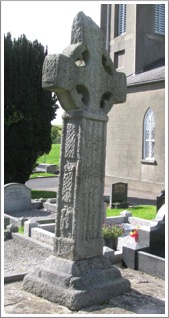
The Cross East Face:
The plinth has a rectangular panel that may have contained interlace.
E 1: No interpretation is made but two have been suggested. One is David playing his lyre for Saul; the other suggests the Judgment of Solomon.
E 2: No interpretation. There are three unidentified figures.
E 3: Moses Smites Water from the Rock.
E 4 left: David with the Head of Goliath.
E 4 right: David Slays the Lion
E 5: Three unidentified figures.
Head center: The Last Judgment (?)
Head, top: St. Paul overcoming the devil in the form of a bird or winged beast (?).
Head, ring: may have contained interlace.
South Side: See the photo to the right.
Plinth: no decoration.
S 1: Unidentified scene that could be David playing the harp, Solomon holding the child upside down or St. Paul or St. Anthony overcoming the devil in human form.
S. 2: Interlace ending in animal heads at the corners.
S 3: Close interlace.
Head: Interlace decorates the underside of the ring and end of the arm. The top has what may be six animal heads emerging from a center point.
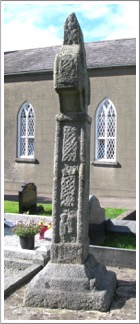
South Side: See the photo to the right.
Plinth: no decoration.
S 1: Unidentified scene that could be David playing the harp, Solomon holding the child upside down or St. Paul or St. Anthony overcoming the devil in human form.
The Photo below left shows the South Side with a detail of the shaft and the North Side, moving from left to right. The source is Harbison, 1992, Vol. 2, Figs. 186, 187, 188.
S. 2: Interlace ending in animal heads at the corners.
S 3: Close interlace.
Head: Interlace decorates the underside of the ring and end of the arm. The top has what may be six animal heads emerging from a center point.
North Side: See the photo below.
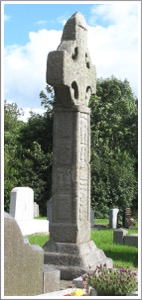
Plinth: unclear decoration.
N 1: close interlace.
N 2: David Encounters/Smites Goliath (?)
N 3: Abraded panel of what was possibly interlace.
N 4: Interlace.
Head: The underside of the ring has two panels, one is uncarved, the other bears interlace. There is a figure, possibly an angel at the end of the arm. The decoration of the top is unclear.
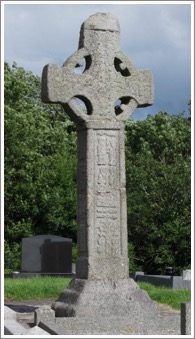
West Face: See the photo to the right.
Plinth: Interlace framed by roll moulding.
This face contains several images but is not divided into separate panels.
W 1: Adam and Eve
W 2: Noah’s Ark W 3: Two unidentified figures.
W 4: The Sacrifice of Isaac (?)
Head: Center is a Crucifixion scene with Stephaton and Longinus. On the arms are the two thieves, each flanked on each side, presumably by soldiers. There are figures of uncertain identity in the constriction of each arm. There is an angel around Jesus’ head.
Top: Two figures that are not identifiable.
Ring: Interlace and cylinders are attached to the inner surface of the ring.
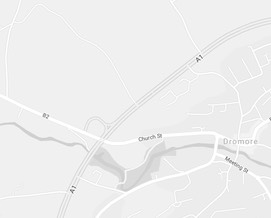
Getting There: See the Road Atlas page 19, C 1. The cross is marked on the map in the Atlas. It is in the Donaghmore Churchyard east of Dromore.
Downpatrick Crosses
The Site
Little is known of the history of Downpatrick and the monastery there. Under the name Dunum, Downpatrick was listed by Ptolemy as a town in Ireland. This would date the town to the early to mid second century. The Gaelic name for the town was Rath Celtchair, named after the mythological Ulster warrior Celtchar. By the 8th century the name was Dun Lethglaise. It did not become Dun Phadraig (Downpatrick) until the 13th century. While the role St. Patrick played in the founding of a church is unknown, the area around Downpatrick was a hotbed of Patrick’s activity. The Saul Church, possibly the first Patrick related ecclesiastical site in Ireland, was the place where tradition suggests Patrick began his ministry. Also nearby are the holy wells at Struell also associated with St. Patrick. At the Synod of Rathbreasil, in 1111 Downpatrick became a diocesan episcopal center. Maol Muire was the first Bishop. He died in 1117. His successor, St. Malachy repaired the church on Cathedral Hill and introduced the Augustinian Canons there in 1138.

What became Downpatrick had been the center of the Dal Fiatach, who were influential in Ulster for centuries. “From the seventh century the dominant power in Ulster was the Dal Fiatach, so much so that the title ‘Rí Uladh’ could simultaneously mean ‘King of Ulster’ and ‘King of the Dál Fiatach’”. (Downpatrick)
In 1177, John de Courcy received a grant of Ulster from King Henry II of England. He captured Downpatrick and ruled most of Antrim and Down. He renamed the town Dun Phadraig and claimed to have found the bones of St. Patrick, St. Brigid and St. Colmcille. In 1186 these remains were reburied in the presence of the Papal Legate, Cardinal Vivian. De Courcy replaced the Canons with Benedictine monks. He also founded a priory and a convent for Cistercian nuns. The priory and convent fell into decay and in 1513 their property was entrusted to the Abbey. (http://www.parishofdownpatrick.org/history/history-of-the-parish?showall=&start=2)
The photo to the right was taken in 2008 and shows the original cross in its original orientation with the road up to the Down Cathedral in the background. Just visible in the far left is the Down County Museum where the cross now resides.
The Cross
In 2015 a new exhibit opened in a new extension at the Down County Museum intended to display Early Christian heritage. At the centre of the display is the original Downpatrick cross. A copy of the cross has taken the place of the original at the east end of the Down Cathedral. The story of the entire preservation project is told in great detail by Michael King in his article entitled “Sacred granite”. (King p. 182)
It is generally agreed that the Downpatrick cross was carved around the year 900 CE. It was probably first erected “at the eastern entrance to the hill-top monastery of Dun Lethglaise that dates to at least 753 CE. The cross later became the Market Cross for Downpatrick and was located at the intersection of English Street, Scotch Street and Irish Street. (King, p. 183)
At some point, the cross was broken and some of the pieces were dispersed. This occurred after 1744. The cross shaft was used as a gate-post. In 1897 Francis Joseph Bigger and William Fennell had the cross re-erected at the east end of the Down Cathedral. (King p. 183)
King makes note that the orientation of the cross at the east end of the Down Cathedral was incorrect. It had the crucification scene facing to the east. This is exactly the opposite of the orientation of the majority of high crosses with crucifixion scenes. This incorrect orientation has been duplicated with the copy that has replace the original at the east end of the Down Cathedral and corrected in the orientation of the original in its new home in the Down County Museum. (King, p. 188) The descriptions of the carving on the cross below are based on the corrected orientation and are, therefore, opposite those even by Peter Harbison in his “The High Crosses of Ireland: An Iconographical and Photographic Survey.”
King goes on to note that: “Photographic recording of the High Cross by Tony Corey of the Historic Environment Division of the DoE assisted greatly in the interpretation of the carvings. Careful study of other Irish Scripture Crosses provided clues to the identification of scenes and allowed James Patience (DoE) to create drawings of how the carvings on the west, east and south sides of the Cross appeared (Figure 5a–b). John Meneely of the School of Natural and Built Environment, Queen’s University Belfast, made a photogrammetric survey of the Cross, which has helped with the identification of a number of subjects among the worn carvings.” (King, p. 190) The drawings of James Patience are below. (King, p. 192) The descriptions below follow those offered by King.

West Face: image to the right.
W 1: Though the lower portion of this panel is actually missing, it can be identified by comparisons with other crosses as the presentation of Christ by the Virgin to Simeon in the Temple.
W 2: The Kiss of Judas at the arrest of Christ.
W 3: Roman soldiers removing a purple cloak and mocking Christ.
W 4: Saints Anthony and Paul sharing bread brought by a raven in the wilderness. This image recalls an event that took place about 346 CE.
Center of Head: The crucifixion with an angel above each of Jesus’ arms and Stephaton with his sponge of sour wine on a pole on the left and Longinus with his spear piercing Jesus’ side on the right.
Arms: On each are there are three figures. These have been interpreted as the theives crucified with Jesus, each flanked by two soldiers.
Michael King offers a significant interpretation of this side of the cross, writing: “Taking all these interpretations together, it is possible to see the west face of the Downpatrick High Cross as representing the theme of the Recognition of Christ. He is first recognised by Simeon in the Temple, and later by Judas and the Roman soldiers. Subsequently, he was acknowledged symbolically by the first hermits Antony and Paul, who came after Christ and recognised Him in the Eucharist, as did the Irish patrons of the Cross themselves (Figure 7a). This theme extends to the Crucifixion scene on the cross-head. Here, the blind spear-bearer, Longinus, to the lower right of Christ, was able to see and recognise Him when blood flowed from Christ’s wounds into his eyes. Similarly, the Good Thief, depicted on the left arm of the cross-head, is said to have recognised Christ and gone to Heaven, in contrast to the Bad Thief on the right (Humphrey and King 2014).” (King, p. 191)
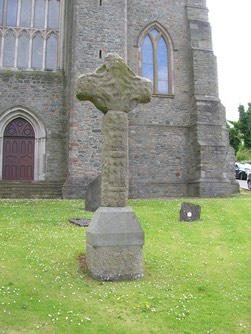

The photo to the left was taken in 2008, and shows the original cross in its original location and orientation. Thus, what we see is the east face of the cross that is described above as the west face. The photo to the right was taken in 2015 shortly before the opening of the new exhibit.
East Face:
E 1: Adam and Eve cover their nakedness, with the serpent winding around the tree.
E 2: Cain is about to strike his brother Abel. God is depicted on the left, witnessing the first murder.
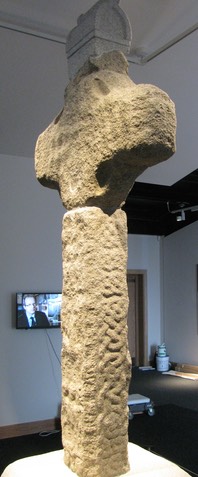
E 3: A possible interpretation of the figure riding on an ass is the Entry of Jesus into Jerusalem.
E 4: Possibly the second coming of Christ. Christ being in the center of the top row.
The photo to the left was taken in 2015, just prior to the opening of the new exhibit.
Head: The head has been interpreted as the Final Judgment. Christ with scepter and cross stands centrally. On the right are four figures clearly moving away from him, the damned. On the right there are five figures that move in the direction of Christ, the saved.
Michael King also offers an interpretation of this face of the cross. “. . we could interpret this side of the High Cross as presenting the Redemption offered by Christ; the chance for every Christian to enter the Heavenly Jerusalem with Christ, and reject the Original Sin of Adam and Eve. The story is a momentous one that encompasses the biblical history of the World, from the Creation to the Last Judgement (King 2014a). Significantly, this side of the Cross faced the viewer as he or she approached the entrance that led to the monastic site on the Hill of Down, echoing the imagery of Christ entering Jerusalem on the Cross itself. This imagery may have been a deliberate attempt to portray the monastery of Down—where it was believed St Patrick was buried— as the Jerusalem of Ireland.” (King, p. 193)
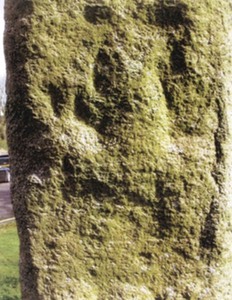
Mike King, based on recent photography and scanning of the Downpatrick cross, identifies a figure riding on a donkey, moving to the left in the same panel where Harbison sees Cain Slays Abel. His conclusion is that “Despite its unusual position and orientation, the Downpatrick rider may indeed echo representations on other northern high crosses of Christ entering the city of Jerusalem upon an ass and accompanied by its colt, before the events of the Passion and Holy Week. The scene may also symbolize the journey of each of Christ’s elect to the heavenly Jerusalem, and as such may have been intended as a universal image of salvation for all those closely examining the high cross, ever since its appearance on, or close to, the Hill of Down some 1,100 years ago.” (King, 2014, p. 19, photo to the right, p. 16)
North and South sides: There is little ornament surviving on the south side. On the north side there is an interlace design of two strands, clearly seen in the photo to the left. (King, p. 193)
North Cross
The North and South crosses are pictured to the left.
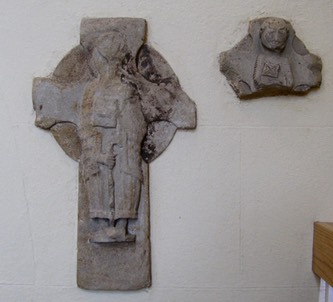
The North Cross is just under two feet in height. It has in imperforate ring. In high relief is the figure of an abbot or bishop wearing a robe and cloak. His right hand holds a drop-headed crozier. His left hand holds what may be a reliquary. The face has broken away. (Harbison, 1992, p. 68)
South Cross
The South Cross is a smaller version of the North Cross. Like the North Cross the figure in high relief holds a cross-decorated book or reliquary. (Harbison, 1992, p. 68)
Two Fragments of One Cross

These two fragments, together, measure more than 1.40m in height. In the figures to the right we have both faces of each of the two fragments. The figures on the left have interlace in the central circle, fretwork on the surviving arm and unknown decoration on the shaft. The other side, shown on the right has a sunken circle in the head, a sunken squared panel on the shaft and interlace on the arm. (Harbison, 1992, p. 68; Vol. 2, Figs 206 and 207)
These two fragments are shown in the photos to the left and right below as they appear on display in the front porch of the Cathedral.
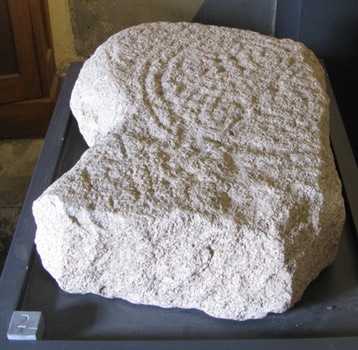

Fragment of Another Cross

This fragment, seen to the left, belonged to another cross. It measures about 20 inches by 20 inches. A tenon protrudes from one side. On one face is a hollow square, on the other face a panel of spiral decoration.
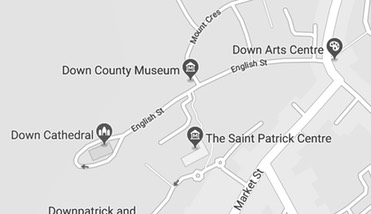
Getting There: See the Road Atlas page 20, F/G 2. The Cathedral and Down County Museum are both located uphill just to the north of towne centre. The map is cropped from Google Maps.
Dromore
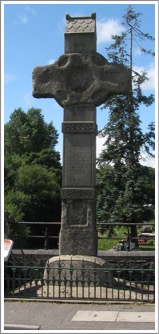
The Site and the Saint
Saint Colman is believed to have established a monastery at Dromore between 500 and 513. It was located on the north bank of the River Lagan in what is likely part of central Dromore today. Colman was educated at Nendrum on Strangford Lough. He is said to have studied with Saint Coelan. Colman’s tenure at Dromore is unknown but he seems to have had both the title of Abbot and Bishop. The attribution of the foundation to Colman is attested to by the presence in the Cathedral of the Church of Ireland in Dromore of a stone known as “Saint Colman’s Pillow.” Nearby is a well known as Saint Colman’s Well. Little is known of the early years of the monastery.
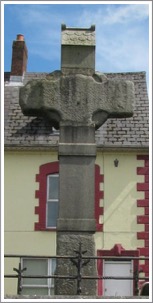
The Cross
The Dromore Cross is carved of granite and dates to the 9th or 10th century. What we have today are the base, part of the shaft and the center and arms of the head. The photo to the left shows the East Face of the Cross, that to the right shows the West Face.
The cross was restored with modern parts in 1887. An inscription reads: "The ancient historical cross of Dromore. Erected and restored after many years of neglect by public subscription to which the Board of Public Works were contributors, under the auspices of the Town Commissioners of Dromore, County Down, 21. D. 1887.” (http://www.lisburn.com/books/dromore-diocese/parish-dromore.html)
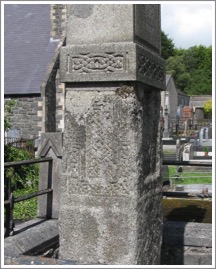
Harbison describes the parts of the original Cross. The base has roll mouldings and a rounded top.
The shaft fragment as geometric design on each side. Each side has a central panel surrounded by interlace. The panel on the east side is worn. The panel on the south side contains fretwork. The panel on the west side may have a fretwork pattern. The north side panel contains interlace. The photo to the left shows the panel on the south side of the cross.
The head of the cross is unperforated with a “concave central depression and with a sunken square panel on one arm.” (Harbison, 1992, p. 70)

Getting There: See the Road Atlas page 19, D 1. The cross is located in towne centre near the river on the Grounds of the Dromore Cathedral. The map is cropped from Google maps.
Drumgoolan Cross
The Drumgoolan Cross is presently stored on the grounds of Castlewellan Forest Park. A replica stands in the center of town. The cross seems to have originally been connected with the parish church of Drumgoolan, about three miles northwest of there. Harbison indicates it was moved from there about 1778. Bigger, writing in 1908 suggests it was built into a wall when he described it. Harbison confirms this, telling us it was at one time built into the wall of the school at Drumgoolan. Fitzpatrick, writing in 1909 describes it as standing near the church door at Drumgoolan. (Bigger, p. 57; Fitzpatrick, p. 45; Harbison, 1992, p. 75.)
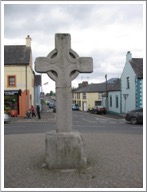
The image to the left below shows the west face of the cross. The image below right shows the east face of the cross.
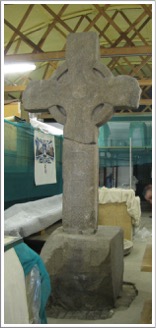
West Face: Bigger describes the west face as follows, “Traces of Celtic interlacing can still be seen in a sunk panel extending across the arms and down the shaft. The centre has a ring enclosing ball ornament. There are no figures on the exposed side of the cross and the circle is solid with the arms and shaft. Close to the ground on the three visible sides of the base are three deeply-sunk panels, but whether they were for ornament or for the inserting of other blocks . . . is difficult to say.” (Bigger, p. 57) To this Harbison adds that the shaft is divided into four panels. Interlace can be seen on the lowest of these but the rest are too worn to identify. (Harbison, 1992, p. 76)
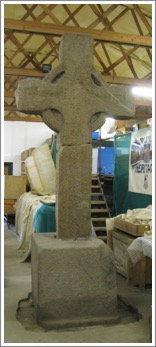
North Side: There is a sunken panel the length of the shaft decorated with interlace.
East Face: A sunken panel the length of the shaft is decorated with interlace. The frame around it may have been decorated with fretwork. "The head has a circular panel with a small boss in the centre surrounded by four, or more probably eight, similar bosses, placed like eggs in a nest." There is interlace in sunken panels on the top and arms of the cross. (Harbison, 1992, p. 75)
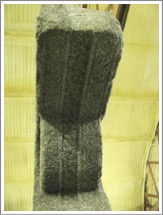
South Side: A sunken panel runs up the shaft and onto the underside of the arms. It is decorated with interlace. The frame around it has interlace on the left and running S-spirals on the right. (Harbison, 1992, p. 75-76) See the photo to the left.
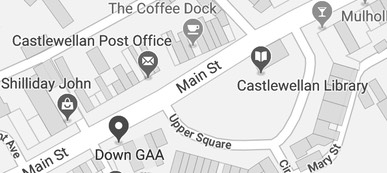
Getting There: See the Road Atlas page 20, E 3. A copy of the cross is located in the area south of the Castlewellan Library. The map above is cropped from Google maps.

Kilbroney Cross
The Site and the Saint
This cross is located in an old churchyard at Kilbroney, just north of Rostrevor. Tradition tells us it was the site of an early convent founded by Saint Bronagh in the 5th century. The early name was Cell Bronche or the Church of Bronach. Legend also states that the convent was established to aid shipwrecked sailors on the shores of nearby Carlingford Lough.
Saint Bronach was a disciple of Saint Patrick. Her importance is indicated by the early attribution of the foundation of the convent to her. The range of her influence is indicated by the depiction of Saint Bronach in a modern stained glass window in All Saints Church, Ballymeena, in County Antrim, pictured right. (http://en.wikipedia.org/wiki/BrónachSaint)
In the late 19th century a storm felled an old oak tree in the churchyard and a 10th century bell was recovered from the branches. It is said that the ringing of the bell warned of a storm brewing in the Carlingford Lough. Note that in the stained glass window Saint Bronach is holding a bell in her left hand.
The Cross
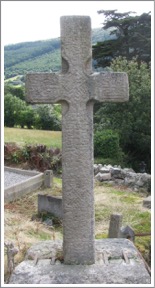
The High Cross located in the churchyard is made of Mourne granite and may, like the bell, date to the 9th or 10th century, though King suggests it may come from the early period of the development of the high cross in Ireland. (King, 2001, p. 3) The presence of the cross is an indication of the prestige and wealth of the convent. It is decorated only on the west face and has no ring. The photo to the left below shows the west face, the photo to the right the east face.
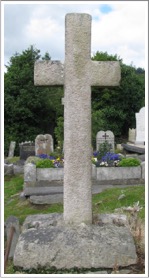
Harbison describes the geometric ornament as follows:
W 1: T-shaped decoration.
W 2: Too worn to identify.
W 3: Angular fretwork.
W 4: Too worn to see anything clearly.
W 5: ‘Angular spiral’ decoration.
Head: centre: A lozenge-shaped panel with ‘angular spiral’ decoration, and with undecorated triangles above and below;
Arms: T-shaped decoration; top: ‘Angular spiral’ decoration. (Harbison, 1992, p. 113)
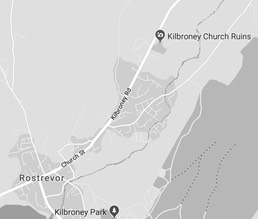
King describes the center of the crosshead as having a lozenge symbol filled with key ornament in low relief at the center of the crosshead. (King, 2001, p. 3) He identifies the lozenge shape as an image of the stone removed from the tomb and therefore, an image of the resurrection. He writes: “The lozenge on the cross reminds the informed viewer that the Resurrection of Christ is implied within the symbolism of the cross. It is a reminder that, through his martyrdom on the cross, Christ was triumphant, rising again after three days, when an angel descended from Heaven and rolled back the stone from the door to Christ’s tomb.” (King, 2001, p. 11)
Getting There: See the Road Atlas page 19, C 5. The church site is located along the B25 just to the north of Rostrevor, on the east side of the road. The map is cropped from Google Maps.
Resources Cited
Belfast and County Down Railway Company, Official Tourist Guide to County Down and the Mourne Mountains, 1924.
Bigger, Francis Joseph, “The Ancient Cross of Drumgolan in the Co. Down,” Ulster Journal of Archaeology, Second Series, Vol. 14, No. 2/3 (May-Aug, 1908), pp. 56-58.
Bigger, Francis Joseph and Fennell, William J., “The High Cross at Downpatrick”, Ulster Journal of Archaeology, Second Series, Vol. 3, No. 4 (July, 1897), pp. 272-274.
Brennan, J. V., “Catholic Bangor and Its Old Abbey”, The Irish Monthly, Vol. 48, No. 568 (Oct., 1920), pp. 509-513.
Brooks, Catherine, “Parish of Donaghmore”, http://www.lisburn.com/books/dromore-diocese/parish-donaghmore.html, accessed March 2015.
Cowan, J. Davison, An Ancient Irish Parish Past and Present: Being the Parish of Donaghmore, County Down, David Nutt, London. http://archive.org/stream/ancientirishpari00cowarich/ancientirishpari00cowarich_djvu.txt, accessed March 2015.
Crawford, Henry S., “A Descriptive List of the Early Irish Crosses”, The Journal of the Royal Society of Antiquaries of Ireland, Fifth Series, Vol. 37, No. 2, June 30, 1907, pp. 187-239.
Downpatrick: https://en.wikipedia.org/wiki/Downpatrick#Early_history
Downpatrick High Cross Extension Project: http://www.downcountymuseum.com/What-s-New/Downpatrick_High_Cross_Exension_Project.aspx
Dromore Diocese: http://www.lisburn.com/books/dromore-diocese/parish-dromore.html
Fitzpatrick,Thomas, “The Ancient Cross of Drumgoolan, Co. Down,” Ulster Journal of Archaeology, Second Series, Vol. 15, No. 1 (Feb., 1909), pp. 45-47.
Harbison, Peter; "The High Crosses of Ireland: An Iconographical and Photographic Survey", Dr. Rudolf Habelt GMBH, Bonn, 1992. Volume 1: Text, Volume 2: Photographic Survey; Volume 3: Illustrations of Comparative Iconography.
King, Mike, “Christ’s Entry into Jerusalem on the Northern High Crosses”, Archaeology Ireland, Vol. 28, No. 1, Spring 2014, pp. 16-19. For the entire article: http://www.academia.edu/6684549/Christs_Entry_into_Jerusalem_on_the_northern_High_Crosses
King, Mike, “The Downpatrick High Cross — Sharing Bread from Heaven”, Archaeology Ireland, Winter 2013, pp. 15-18. For the entire article: http://www.academia.edu/5493635/Sharing_Bread_from_Heaven_-_The_Downpatrick_High_Cross
King, Mike, “Diamonds are Forever: The Kilbroney Cross, the Book of Kells and an Early Christian Symbol of the Resurrection”, Journal of the Lecale Historical Society, No. 19, 2001, pp. 3-13. For the entire article: http://www.academia.edu/7113832/Diamonds_are_Forever_the_Kilbroney_Cross_the_Book_of_Kells_and_an_Early_Christian_Symbol_of_the_Resurrection
King, Michael, “Sacred granite: Preserving the Downpatrick Cross”, in Cultures of Stone: An Interdisciplinary Approach to the Materiality of Stone, edited by Gabriel Cooney, Bernard Gilhooly, Niamh Kelly and Sol Mallia-Guest. pp. 181-196.
Meehan, Cary, "The Traveller’s Guide to Sacred Ireland", Gothic Image Publications, Gastonbury, Somerset, England, 2002.
“Miscellanea”, The Journal of the Royal Society of Antiquaries of Ireland, Fifth Series, Vol. 7, No. 3, , Sep. 30, 1897. pp. 245-246